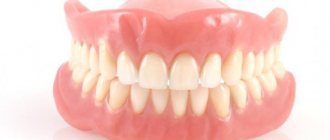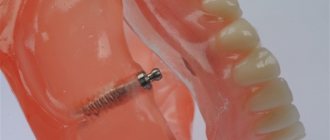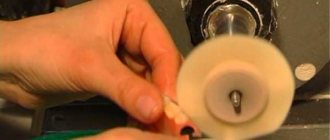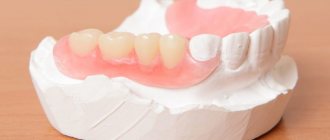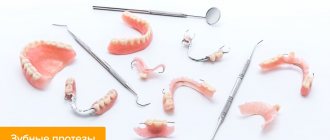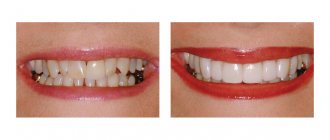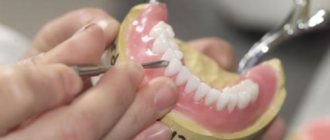1974
To fix the prosthesis in the mouth, preventing it from moving, clasps are used in orthopedics.
With their help, pressure is redistributed during the act of chewing. At the same time, they cover the dental unit only 2/3 of its circumference, creating support and ensuring retention of the prosthesis.
What is a clasp?
The clasp is an integral part of a removable denture and looks like specific hooks. Its purpose is to hold the denture. The fixing structure itself is assembled from several parts:
- Occlusal overlay – helps distribute the load on the supporting dental units.
- The body is a stationary area located closer to the upper pole of the chewing element. Connects all components.
- Shoulder – gives a springing effect when the denture is displaced, covers the area of the dental crown. Contains a supporting part (prevents movement to the side, imparts rigidity) and a holding part (fixing action).
- Process – connects the fixing part with the prosthesis, often covered with a base or crowns.
The task of clasps is to fix the prosthesis
To use the clasp system, you must have your own chewing elements that will serve as a support. Primary requirements:
- Sustainability.
- Functional relationship to the opposing unit of the other jaw arch. The components of the fixation will make the bite higher in the case of natural close contact during chewing or closing of the jaws.
- Classic anatomical shape. Selection with a non-standard configuration is quite risky and impractical.
- Full treatment.
Selecting a clasp system is not an easy task for a dentist. The installation is considered successful if:
- The bite does not increase.
- Rotational movements of the denture are excluded.
- The load is evenly distributed among all support units.
- The components of the retainer are practically invisible or completely invisible.
Clasps for dentures are made from wire or by casting.
The condition for strong attachment is the presence of strong supporting teeth.
Background of creation
In 1949 of the last century, American researchers (dentists, mathematicians and metallurgists) developed and implemented the Ney system. The principle of the new system was the use of clasps made by casting, which load the tooth only in the axial direction.
This technique has become a breakthrough in prosthetics, since when installing clasps there is no need to wear crowns, and its use is possible for any condition of the teeth.
In addition, the newest procedure turned out to be safe for the patient, since it does not cause traumatic damage to the surface enamel.
Types of clasps
Let us next consider several common types of clasps.
Material
Fixing elements for removable dentures can be made of various materials:
- Metal. Most often, products are made of medical steel, chromium-cobalt or gold-platinum alloy. These materials are highly durable and ensure maximum service life of the entire structure.
- Plastic. They are used in butterfly prostheses and nylon elastic structures. Designed to perform a holding function, since they are prone to deformation and breakage under chewing loads.
- Combined. Contains both metal and plastic elements. Most often, this type is used in orthopedic pads.
Tooth Coverage
The coverage of teeth by clasps can vary significantly in different designs. Thus, there are dentures with single-arm, double-arm, T-shaped, multi-link, double and reversible methods of covering the supporting teeth.
Each method of placement on the dental surface has both advantages and disadvantages, so the choice of a specific fixation method depends on the specific clinical situation.
Form
Depending on the cross-sectional shape, round, semicircular and ribbon clasps are distinguished.
Round clamps are the easiest to manufacture. They ensure effective fastening of the prosthesis if placed correctly and a sufficient number of support units are used.
Semicircular clasps are used when covering abutment teeth with metal crowns. They are usually made from a spring alloy.
Tape hooks are used less and less due to the difficulty of fitting them to the tooth surface.
Connection to base
There are three options for connecting the clasp to the prosthetic structure:
- Rigid fixation involves a fixed attachment of the hook to the base, as a result of which the chewing load is transferred to the teeth through the clasp.
- The spring connection is ensured using a spring extension. The pressure of the prosthesis is only partially transferred to the teeth.
- The articular connection is made using a hinge. In this case, there is completely no pressure on the supporting teeth, and the load is placed on the mucous membrane of the alveolar ridge.
Functions
According to the variety of functions they perform, clasps can be supporting, holding, or combined.
This is interesting: New generation dentures: removable and fixed
Support products are attached to the canines and molars using hooks and participate in the process of redistributing the chewing load.
Retaining elements are designed to secure the prosthesis to the elements of the jaw arch when performing vertical movements.
In combined support-retaining clasps, various types of load are redistributed between periodontal tissues and the prosthetic bed.
Other types of fasteners
Bonneville flip design
Bonneville is a variation of Acker, but the shoulders are directed in opposite directions. The retainer is designed for a continuous row of teeth. The design reliably fixes the prosthesis and creates high-quality support for it. The fastener also masks the gaps located between the teeth.
Other advantages of the Bonneville flip-over design:
- prevents food from getting stuck in areas considered difficult to reach;
- prevents the occurrence of certain pathologies of the oral cavity;
- prevents the development of an inflammatory process in the gums.
Swenson
Swenson - a clasp used on fangs
The product creates a reasonable load on the supporting teeth, which is especially important when they are mobile
Disadvantage: Some space between molar and premolar is required to secure the anterior shoulder of the product.
Double single arm design
There are two types of products:
- For the upper jaw - used from the side of the entire dentition and for two molars located next to each other.
- For the lower jaw - used in the presence of two converging molars.
Jackson
Jackson is a reversible clasp. This is a type of support-retaining device. The design has two branches and two bodies, is made in the form of a loop, and is also made in two ways - bent and cast.
Video: denture with and without clasp.
Adams
Adams is a universal clasp. The design fits tightly to the support, which ensures high-quality fixation of the prosthesis.
Dentoalveolar clasp
Dentoalveolar clasp - plastic is used for production. Used on front teeth in aesthetically significant areas of the oral cavity. For reliability, the plastic is reinforced with wire. This increases the strength of the structure, but negatively affects the quality of the material.
Flaws:
- the lip is slightly deformed, protruding forward, which negatively affects the appearance;
- cannot be used for supports with a low crown;
- records are not reused;
- cannot be used for the alveolar process.
The reliability of fixation of the prosthesis and the aesthetics of the smile depend on the clasp. For this reason, it is recommended to approach the choice of design with all responsibility.
Design features
Retaining type clasps consist of the following elements:
- The shoulder performs the function of holding the clasp on the tooth surface. This element ensures the spring properties of the structure and the transfer of pressure to the support unit. The shoulder should not have sharp protrusions to avoid injury to the gum tissue and cheek.
- The body is an element of the product placed on the surface of the tooth and connecting the shoulder and the process of the clasp.
- The process performs the function of fixing the fastening in the prosthetic structure. Placed under the plastic components of the hook.
In support-retaining clasps, in addition to the shoulder and body, there is an occlusal pad that prevents tooth displacement when pressure occurs on it, and an anchor part - an element connecting the clasp to the metal base.
Roach design
This design is also known as a split clasp, which is due to the peculiarity of its structure. The clasp has two T-shaped arms. In addition, the product has one occlusal pad. Most often used for clasp prosthetics.
Due to the reduced contact of the shoulder with the tooth surface, stabilization of the prosthesis is ensured. Practicing orthodontists recommend using the structure in combination with anchor mechanisms of increased rigidity.
Pros:
- good retention of supporting elements;
- aesthetics;
- minimal risk of developing caries due to the lack of impact on the enamel;
- can be used for short teeth, as well as for units that are inclined;
- Relatively simple adjustment of the retinal edge.
Minuses:
- inability to use with pronounced bone protrusions;
- lower efficiency compared to the anchor mechanism;
- limiting use for teeth located in the smile zone;
- risk of damage due to improper use.
Boundary line
The location of the boundary line is of great importance when choosing the type of clasps to be installed.
There are 5 options for its placement:
- The boundary line originates from the contact point of the row element on the side where the pathology is located and descends to the center of the proximal region of the adjacent tooth. In this case, the use of clasps with long holding arms is effective.
- The equator line is located in the center of the approximal surface and is directed towards the contact point of the adjacent tooth along the lingual or buccal side. The situation requires the use of support and retention mechanisms.
- The boundary line is placed diagonally on the surface of the supporting element - from the chewing area in the defect area to the neck of the element on the reverse side. Experts prefer to use Ney clasps for this pathology.
- The boundary line is located low, the equator passes in the area of the tooth neck . To fix the prosthetic structure, the use of support clasps is required.
- A high location of the equator occurs in cases of increased tooth abrasion. To restore their functionality and appearance, artificial crowns are required.
Retention clasp
It is a subsequent invention after the conventional wire clasp. The wire structure was a hook, which is installed on the tooth itself near its neck. Later this clasp was modernized and at the moment it has several varieties. Retaining types of clasps include: alveolar and dentoalveolar.
A classic support-retaining clasp consists of two arms, a process and an occlusion pad. One of the best representatives of this type of clasp is the Ney system. Since the clasp fracture mainly occurs near the base of the prosthesis, the upper shoulder part and the body itself were created thick and rigid. Since the upper part became rigid, it began to be positioned higher than the center line. As a result, such a placement of the clasp began to provide a supporting installation and at the same time prevent the lateral displacement of the prosthesis itself. In addition, the lowest thin part is located slightly lower than the boundary line. As a result, it serves as a supporting element and does not allow lateral displacement of the prosthesis. The lower part securely fixes the prosthesis itself. The upper part is located higher than the boundary line.
Ney system
The methods were introduced into orthodontics by Ney in the middle of the last century. These are classic support-retaining clamps. They contain a process, two shoulder elements and an occlusal type overlay.
To minimize fastener fracture, the areas located closer to the base were made thicker and stronger, while the distant sections gradually became thinner, and the product took on the shape of a horn.
Ney devices include the following options:
- Single-armed.
- Forked Roach.
- Acker with two shoulders.
- Ring single-arm.
- Combined.
General characteristics include practicality, wear resistance, and high aesthetics.
Roach
It is a rod type of fixer. Has a springy effect due to its long arms.
The advantages include:
- uniform pressure distribution,
- aesthetics.
- retainer of choice in case of short teeth,
- good holding characteristics.
Roach clasps
- Limited choice of material; this type is made exclusively from chromium or nickel. Therefore, it is not prescribed for patients with metal allergies.
- Not applicable for anatomical features of the jaw arch and teeth, when the gums of the upper jaw are exposed when smiling
- High load on the alveolar processes
Adams clasp
Versatile and durable fastener. Capable of fixing both to single chewing elements and to a full row of teeth. Adams are installed on the first premolars and molars.
Acker's clasp
One of the most effective and affordable fasteners. Installed on molars in the absence of one or more chewing elements and intact supports. Simple in design, it reliably keeps clasp dentures from moving.
The rigidity of the model’s frame can be considered both a plus and a relative minus, depending on the situation.
Various types of clasps
Jackson
Jackson clasp is a combined design of a flip-over type. It has the shape of a loop; the supporting part is considered to be the part that is located in the interdental spaces. Made from wire or casting.
Bonneville
A modification of the Acker clamp is the Bonville clasp. This type is based on two occlusal overlays. They are placed in an anatomical gap located on the chewing surface of the abutment tooth. Additionally, two shoulders are used.
The purpose of the design is to retain and provide stability for unilateral dentition defects. The peculiarity of the structure prevents food from entering the interdental spaces, reducing the risk of inflammatory processes in the oral cavity.
Schwartz
A type of arrow-shaped fastening of a point configuration, it can be one- or two-link. This type is widely used in orthodontic practice due to its high fixation ability. The product is only available in wire.
Multi-link clasps
Consists of humeral processes connected to each other. This fixation is adjacent to each tooth and is shaped like a semi-oval. Manufactured in the following form:
- Wide stripes are a type of Cross-Shredder.
- Narrow stripes are a variation of Kennedy.
Multi-link clasps
They play the role of combining the parts of the denture and fixing them.
The choice of clasp system is individual in each case. The basis for preference is the volume of prosthetics and the initial state of the dentition.
Combined
Clasps of the third type combine elasticity and pronounced rigidity of the first two types. It is allowed to use the product for any part of the jaw row; the location of the product on the row is oral or vestibular. On the lingual side, clasps are placed for the lower jaw if the tooth acts as a supporting one. For the upper jaw, a structure of the second type is placed on the side of the cheek, and an anchor on the side of the palate.
Single shoulder ring
Products of type 5 have 3 options for use, on the upper or lower jaw and a clasp with one lining. This type of clasp connection is installed on molars.
In this case, it is allowed to tilt towards the oral side on the mandibular row. On the upper row, the design can be used if the tooth is tilted in the opposite (vestibular) direction.
The peculiarity of the clasp is that it consists of one or two occlusal pads, and an elongated arm that covers the surrounding dental unit. This attachment creates rigidity, strength and stability of the prosthesis.
Due to the large length of the ring clasp, the likelihood of its deformation increases. Therefore, the structure is strengthened by connecting the rod to the shoulder and the distal pad to the arch on the maxillary row.
The same sequence of connecting elements with the base on the mandibular row allows you to significantly increase the strength of the orthopedic product.
This type of construction has a complex structure, which is why food debris can accumulate under its surface. This can cause the development of caries or inflammatory diseases of the gum tissue.
Need to know! Practitioners initially place crowns on single molars, after which clasps are installed. This ensures proper hygienic care.
The video presents the principle of creating clasps.
Arrow-shaped
Most often, this option is used to strengthen orthodontic plates. For installation, the interdental space is used, located below the equator line of the tooth.
conclusions
Despite the fact that Ney clasps were developed in the middle of the last century, their use is still relevant today.
The simplicity of the design ensures high practicality, wear resistance, and, importantly, after installation a high degree of aesthetic value is noted.
In addition, to minimize the occurrence of breakage, areas located closer to the base are made thicker and more durable, and distant sections tend to gradually thin out, taking on the shape of the oral cavity.
If you find an error, please select a piece of text and press Ctrl+Enter.
Tags: removable dentures
Did you like the article? stay tuned
Previous article
Aquasplint is an innovative method of treating and diagnosing TMJ abnormalities
Next article
How to effectively and quickly remove plaque?
Pros and cons of nylon
There are also nylon - one-piece dentures with clasps for attaching to abutment teeth
The main positive quality of nylon is the ability to create any shade, so it is easy for the dentist to choose the color of the base. Clasps for nylon dentures are poured simultaneously with the base, so they merge and do not stand out when you smile. The thin layer of plastic is not felt when chewing and talking.
But some patients are dissatisfied with nylon prostheses with clasps:
- atrophy of gum tissue and its subsidence are possible;
- dentures deteriorate faster and become deformed;
- sometimes there is pain when biting and chewing;
- you have to visit the dentist more often for correction;
- the likelihood of developing infections, stomatitis, and gingivitis increases.
More modern versions of Acry-free from an Israeli manufacturer are manufactured using software and scanning of the oral cavity. They are distinguished by high aesthetics, perfectly follow the contours of the gums, therefore they are invisible and practical. Suitable for full or partial dentures, replacement of dentures with metal clasps.
Requirements for the location of clasps
To successfully install clasps you must:
- So that the tooth itself is very stable. If the doctor identifies pathological mobility, he will attempt to block it in order to ultimately obtain a stable system. If the patient’s teeth have inflammatory processes at the apex of the tooth, then before installing the support they must be sealed.
- So that the teeth have the correct anatomical shape. Teeth with a rather low crown along the cone, with an incorrect ratio of the length of the root and the clinical crown itself, as well as teeth with an exposed neck, are not suitable for installing clasps. The listed symptoms are relative. They can be eliminated and you can safely proceed to installing clasps.
- So that the supporting tooth has the correct relationship with the antagonist. Relationships can be very close. In this case, even a very small pad, which is placed in the fissure itself, greatly disrupts the bite. In such a situation, a completely different tooth is chosen to install the supporting element. Another solution is to install a protective crown on the initially selected abutment tooth.
How clasps are made
The hook with which the denture is fixed can be made only using existing theoretical knowledge and concepts of a particular specialty. To make the right clasp, you need to know what types of prostheses will be attached with its help. The manufacturing technology of any clasps has the same sequence of actions. Here it is very important only to correctly follow the stages of the entire process and select the right material.
The clasp is always bent with pliers. Any dental technician has them in his arsenal. You can also use round nose pliers and pliers to make a clasp, with which you can make only three bends.
To obtain the clasp arm itself, designed to cover the tooth, one end of the cast wire is bent. The next bend is made using round nose pliers. Using these tools, the body of the clasp is also formed.
Requirements for making a shoulder
- Firstly, the design of the shoulder itself must be made so that it can cover the tooth from the cervical or labial side. It should be located behind the convexity line or otherwise between the gum and the equator.
- The shoulder should not create pressure on the supporting tooth itself, that is, it should be passive.
- Regardless of whether the shoulder is flat or round, it should touch the entire surface of the tooth as much as possible. If the fit is carried out only at one point, this means that increased pressure will be created on the tooth and, over time, the enamel will be erased.
- After the main stages of shaping, the shoulder must be rounded and polished. This is necessary in order to prevent possible injury to the mucous membranes.
- The shoulder must be elastic. The best in this case are wire clasps, not so good - cast ones. However, cast ones more accurately replicate the features of the tooth relief.
Execution of the contact process
In order to fix the created clasp shape, you must use round nose pliers. It is best to bend to the ridge using pliers. Next, the resulting process is crushed on an anvil and notches are made on it so that it is more firmly attached to the base.
Only single-arm clasps are made using the described method. In the case of double-arm execution, the sequence of actions is the same, only two elements are involved in the manufacturing technology.
Manufacturing
There are several ways to make clasps. Plastic products are usually made by injection molding. First, the product is shaped using wax, then it is replaced with the base material. Stamped models are produced by stamping from metal alloys. Bent systems are made using tongs. The technician may also use pliers or needle nose pliers. With their help, the master gives the wire the desired shape.
Stages of making a clasp using the bent method:
- using pliers, one end of the wire is bent to create the shoulder of the product;
- a second bend of the wire is performed to form the body;
- the wire is bent a third time to form an appendage.
Basic principles of the Ney system
The clasps are manufactured using injection molding technology, which ensures a variable cross-section of elements (horn-shaped arms), precision, compactness and ergonomic design.
The arms that support the rods and other parts of the clasps have an increased cross-section in areas of greatest stress.
The variety of types of Ney designs makes it possible to satisfactorily solve the problem of attaching clasp dentures in various clinical situations.

